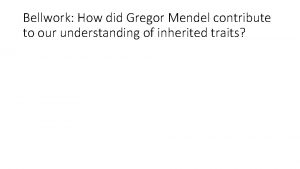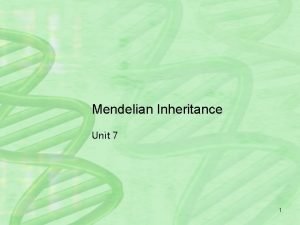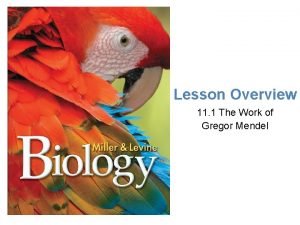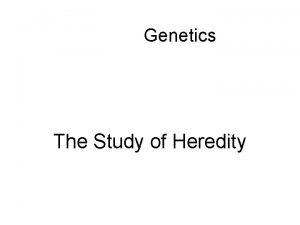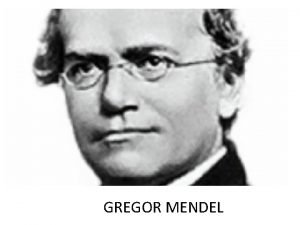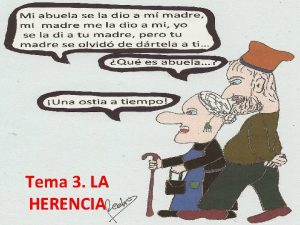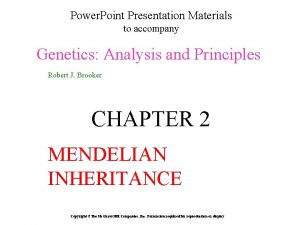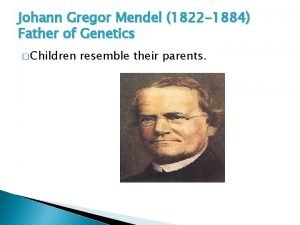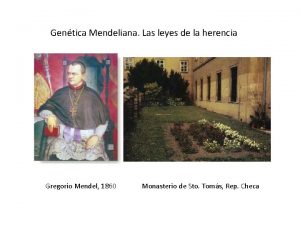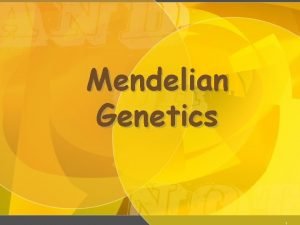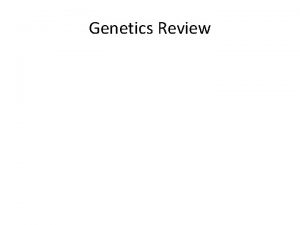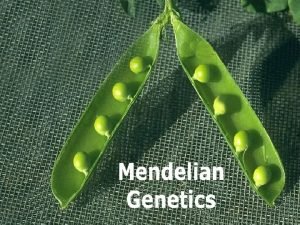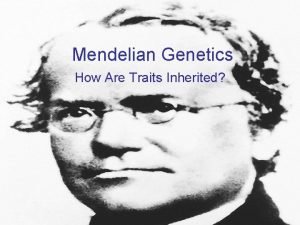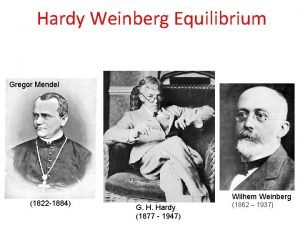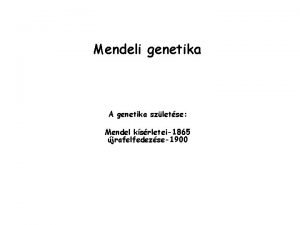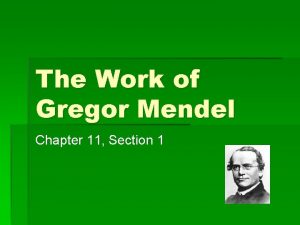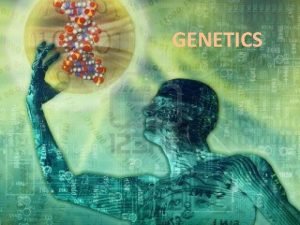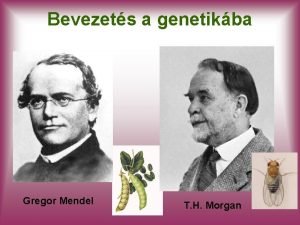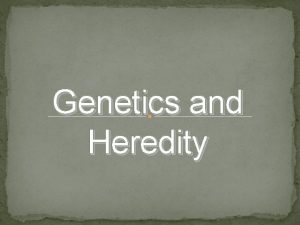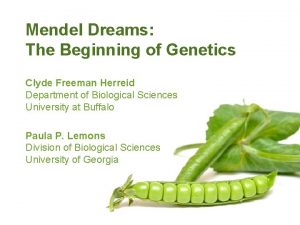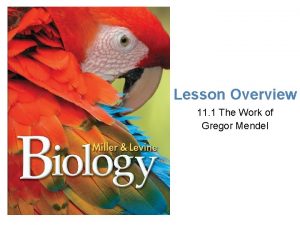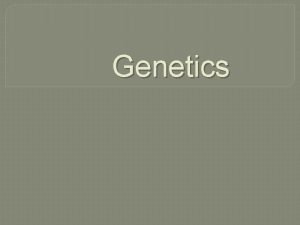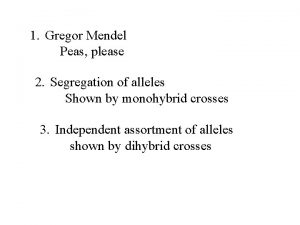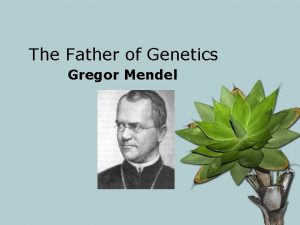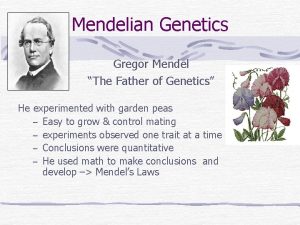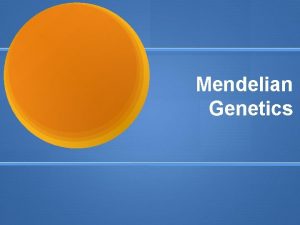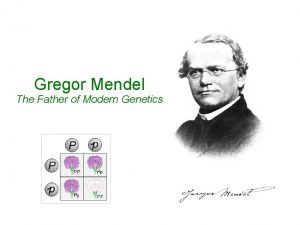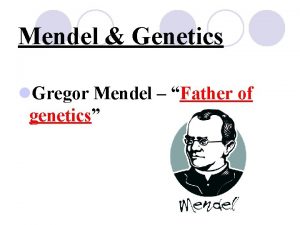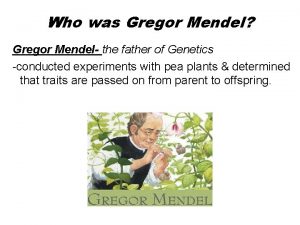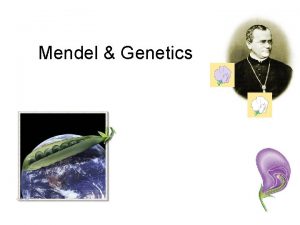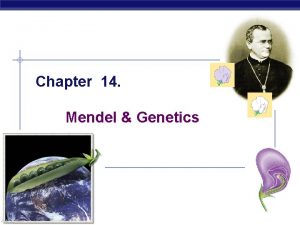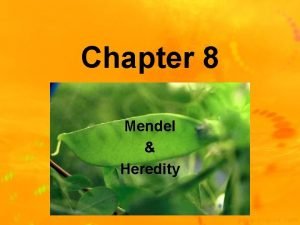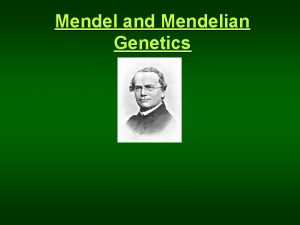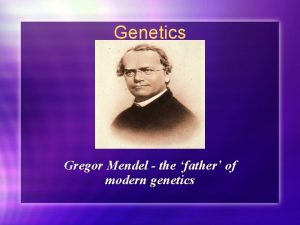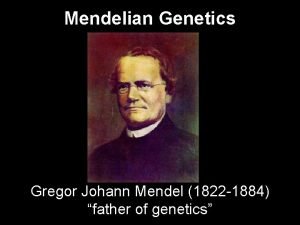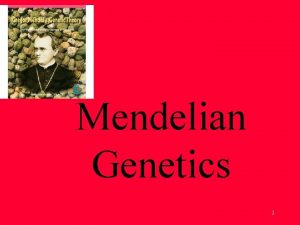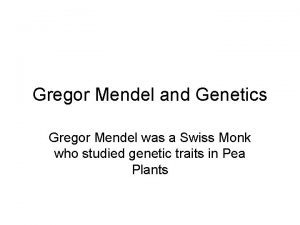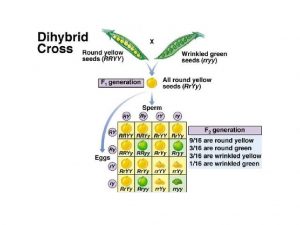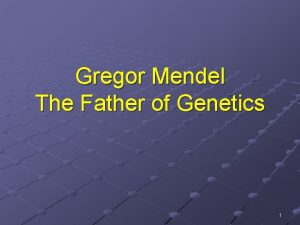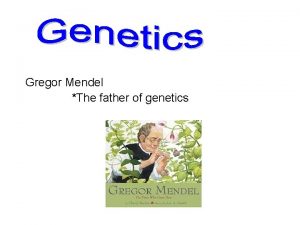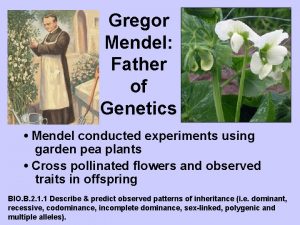Mendelian genetics Gregor Mendel Father of modern genetics










































- Slides: 42

Mendelian genetics

Gregor Mendel • Father of modern genetics • Researched with pea plants •

Gregor Mendel • Father of modern genetics • Researched with pea plants • Developed ideas of dominance and trait segregation

Phenotype • Phenotype – Physical characteristics

Genotype • Phenotype – Physical characteristics • Genotype – Genes we inherit from our parents

Phenotype Notice the similarities: – Facial structure

Phenotype Notice the similarities: – Facial structure – Eyes

Phenotype Notice the similarities: – Facial structure – Eyes – Smile

Phenotype Notice the similarities: – – Facial structure Eyes Smile Ears

Phenotype Notice the similarities: – – – Facial structure Eyes Smile Ears Nose

Phenotype Notice the similarities: – – – Facial structure Eyes Smile Ears Nose Neck

Mendelian Genetics Mendel studied a number of characteristics in pea plants including: • Height - short or TALL

Mendelian Genetics Mendel studied a number of characteristics in pea plants including: • Height - short or TALL • Seed color - green or YELLOW

Mendelian Genetics Mendel studied a number of characteristics in pea plants including: • Height - short or TALL • Seed color - green or YELLOW • Seed shape - wrinkled or ROUND

Mendelian Genetics Mendel studied a number of characteristics in pea plants including: • Height - short or TALL • Seed color - green or YELLOW • Seed shape - wrinkled or ROUND • Seed coat color - white or GRAY

Mendelian Genetics Mendel studied a number of characteristics in pea plants including: • Height - short or TALL • Seed color - green or YELLOW • Seed shape - wrinkled or ROUND • Seed coat color - white or GRAY • Pod shape - constricted or SMOOTH

Mendelian Genetics Mendel studied a number of characteristics in pea plants including: • Height - short or TALL • Seed color - green or YELLOW • Seed shape - wrinkled or ROUND • Seed coat color - white or GRAY • Pod shape - constricted or SMOOTH • Pod color - yellow or GREEN

Mendelian Genetics Mendel studied a number of characteristics in pea plants including: • Height - short or TALL • Seed color - green or YELLOW • Seed shape - wrinkled or ROUND • Seed coat color - white or GRAY • Pod shape - constricted or SMOOTH • Pod color - yellow or GREEN • Flower position - terminal or AXIAL

Mendelian Genetics We will work with the following three: • Height - short or TALL • Seed color - green or YELLOW • Seed shape - wrinkled or ROUND • Seed coat color - white or GRAY • Pod shape - constricted or SMOOTH • Pod color - yellow or GREEN • Flower position - terminal or AXIAL

Predicting Inheritance To determine the chances of inheriting a given trait, scientists use Punnett squares and symbols to represent the genes. UPPERCASE letters are used to represent dominant genes. lowercase letters recessive genes. are used to represent

Predicting Inheritance For example: T = represents the gene for TALL in pea plants t = represents the gene for short in pea plants So: TT & Tt both result in a TALL plant, because T is dominant over t. t is recessive. tt will result in a short plant.

Predicting Inheritance For example: Mendels’ Principle of Dominance T = represents the gene for TALL in pea Some genes (alleles) are dominant and others are plants recessive. The phenotype (trait) of a dominant gene twill= be represents gene short gene. in pea seen when it the is paired withfor a recessive plants So: TT & Tt both result in a TALL plant, because T is dominant over t. t is recessive. tt will result in a short plant.

Predicting Inheritance Let’s cross a totally dominant tall plant (TT) with a short plant (tt). Each plant will give only one of its’ two genes to the offspring or F 1 generation. TT x tt T T t t

Predicting Inheritance Let’s cross a totally dominant tall plant (TT) with a short plant (tt). “Law” of Segregation Mendels’ Each plant will give only one of its’ two genes to Eachoffspring gene (allele) from the other so that the or separates F 1 generation. offspring get only one gene from each parent for a given trait. TT x tt T T t t

Punnett Squares Tt Tt The genes from one parent go here. The genes from the other parent go here. Tt Tt

Punnett Squares T T t Tt Tt

Punnett Squares T T t Tt Tt

Punnett Squares T T t Tt Tt

Punnett Squares T T t Tt Tt

Punnett Squares T T t Tt Tt

Punnett Squares t t T T Tt Tt F 1 generation

Interpreting the Results The genotype for all the offspring is Tt. The genotype ratio is: Tt - 4/4 The phenotype for all the offspring is tall. The phenotype ratio is: tall - 4/4

Punnett Squares T t ? ? Your Turn!! T ? ? t

Punnett Squares T t TT Tt Tt tt F 2 generation

Punnett Squares Next, give the genotype and phenotype T (F 2 generation). t ratios of the offspring T TT Tt tt

Punnett Squares Genotype ratio: TT - 1 T t T TT Tt tt

Punnett Squares Genotype ratio: TT - 1, Tt - 2 T t T TT Tt tt

Punnett Squares Genotype ratio: TT - 1, Tt - 2, tt - 1 T t T TT Tt tt

Punnett Squares Genotype ratio: TT - 1, Tt - 2, tt - 1 T t T TT Tt tt Phenotype ratio: Tall - 3

Punnett Squares Genotype ratio: TT - 1, Tt - 2, tt - 1 T t T TT Tt tt Phenotype ratio: Tall - 3, short - 1

Punnett Squares This is a monohybrid T cross. We worked with t only one trait. The height of the plant. T TT Tt tt

Punnett Squares This is a monohybrid T cross. We worked with t only one trait. The height of the plant. two T TT Tt Later we will work with a dihybrid cross, using the height of the plant and either seed color or seed shape. t Tt tt
 Pp x pp
Pp x pp How did gregor mendel contribute to genetics
How did gregor mendel contribute to genetics Gregor mendel’s principles of genetics apply to
Gregor mendel’s principles of genetics apply to Family resemblance test
Family resemblance test Gregor mendel
Gregor mendel What did gregor mendel do
What did gregor mendel do Gregor mendel
Gregor mendel Gregor mendel
Gregor mendel Section 11.1 the work of gregor mendel
Section 11.1 the work of gregor mendel Gregor mendels work
Gregor mendels work Generacion filial
Generacion filial Gregor mendel laws
Gregor mendel laws Chapter 12 lesson 1 the work of gregor mendel
Chapter 12 lesson 1 the work of gregor mendel Gregor mendel
Gregor mendel Mendels law of segregation
Mendels law of segregation Cruza dihibrida
Cruza dihibrida Austrian monk
Austrian monk What did gregor mendel do
What did gregor mendel do Mendel genetics
Mendel genetics ____________is the austrian monk who experimented with
____________is the austrian monk who experimented with Austrian genetic traits
Austrian genetic traits Gregor mendel laws
Gregor mendel laws Gregor mendel
Gregor mendel Who is gregor mendel
Who is gregor mendel Hardy weinberg equilibrium
Hardy weinberg equilibrium Gregor mendel munkássága
Gregor mendel munkássága Who is gregor mendel and what did he do?
Who is gregor mendel and what did he do? Chapter 12 lesson 1 the work of gregor mendel
Chapter 12 lesson 1 the work of gregor mendel Chapter 11 the work of gregor mendel
Chapter 11 the work of gregor mendel Conclusion gregor mendel
Conclusion gregor mendel Fr gregor mendel
Fr gregor mendel Gregor mendel video
Gregor mendel video Rryy x rryy punnett square
Rryy x rryy punnett square Gregor mendel summary
Gregor mendel summary Gregor johann mendel
Gregor johann mendel What did gregor mendel research
What did gregor mendel research What is the phenotype of a chicken with the genotype fbfw?
What is the phenotype of a chicken with the genotype fbfw? Who is gregor mendel and what is he famous for
Who is gregor mendel and what is he famous for Gregor mendel referat
Gregor mendel referat 11-2 probability and punnett squares answer key
11-2 probability and punnett squares answer key Mendels theory
Mendels theory Gregor mendel
Gregor mendel Gregor mendel laws
Gregor mendel laws

